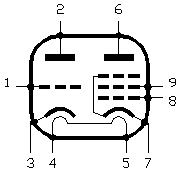> what tubes does the parts of the ECL84 match?
The triode smells like a 12AT7, though maybe a little bigger.
The pentode is the standard video amplifier from late tube-TVs. It is roughly like the output tube in a kitchen radio, except much higher transconductance, softer plate resistance, and much less linear than an "audio" tube.
And TV tubes were generally tuned to work well at lower supply voltages, so I'd think about 200V-250V. This means cheaper caps and lower transformer impedances.
Assuming a mike input transformer, I'd bias the triode with a 100K or 220K plate resistor and trim the cathode resistor to get the plate voltage about 2/3rds of the supply voltage. That's always a good starting point for small triode voltage-amps. Voltage gain will be around 2/3rds of Mu, or about 40.
The output tube... well, you could do a lot of experimenting, but I bet it works OK at the book-value conditions. About 200V supply, transformer or low-value resistor load, about 15mA-20mA plate current. It won't have the voltage swing of a good audio tube, so I'd expect about 100V swing from a 200V power rail. At max-output it could swing 15mA-20mA peak. It will be more linear with less current swing.
Taking 100V and 15mA peak, we need 6.7K load and get 750 milliWatts out. At 100V and 10mA peak we use 10K load for 500mW out. So we are in the +27dBm range at clipping and can probably get well over +18dBm clean.
We could instead bias at 20mA and use a 600Ω resistor DC load. Peak output voltage is 20mA*600Ω or 12V peak, 8.4V RMS. If we add an AC load of 600Ω these numbers are half: 4.2V RMS, +14dBm. A 3K resistor load will make a little more output in 600Ω, maybe +18dBm, but the gain will vary a LOT with load resistance and the sound will vary.
The output gain is roughly Rl*Gm. Gm is roughly 1/100Ω. For 10K transformer, Rp is significant, so the gain at the primary is more like 6K/100Ω or 60. A 10K:600Ω transformer is 4:1, so stage gain to load is 15. For resistance coupling, gain is like 300Ω/100Ω or 3 into a 600Ω load.
While a transformer is expensive, it gives much higher gain, floating output, and avoids a large high-volt output cap. So I'll steer you that way.
With input transformer gain of 1:10, 1st stage gain about 40, second stage gain to 600Ω of about 15, we have total gain of 10*40*15= 6,000 or 75dB. The non-linearity of that video-output tube suggests a hunk of feedback, maybe 20dB. So 55dB gain is easy and clean, 60dB gain won't suck.
Without the transformer, distortion is about twice as high due to poor loading, and about 5 times higher due to less feedback, and much higher above about +10dBm due to just running out of current.
If you are sure your loads will ALWAYS be over about 5K, resistance coupling looks better.
























